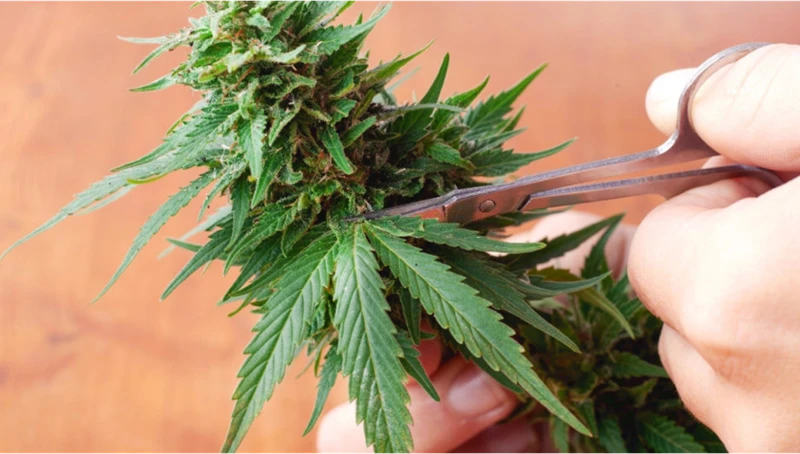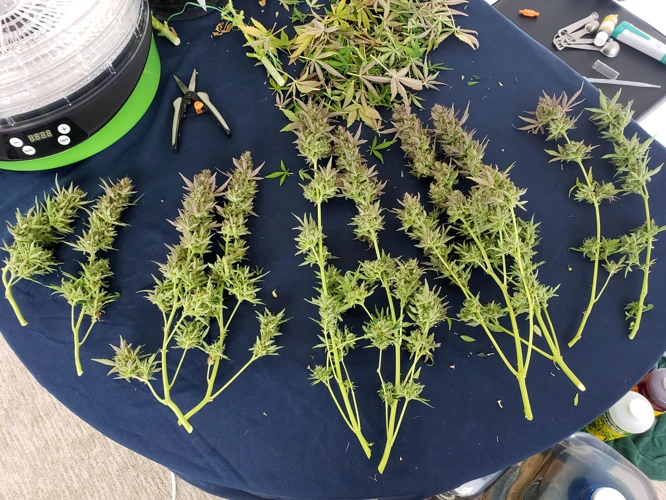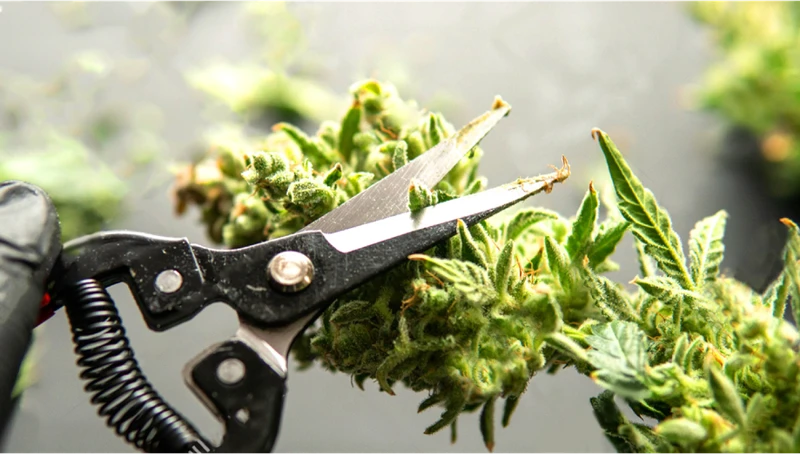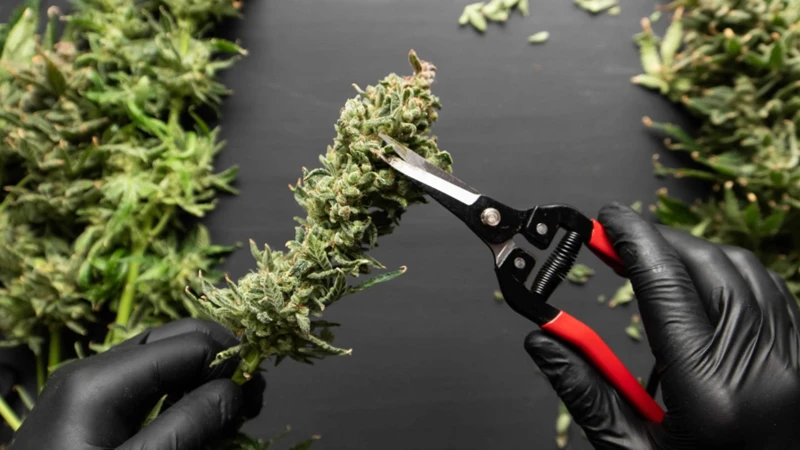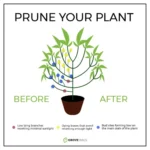
The Significance of Trimming Leaves During Harvesting Cannabis
As the harvest season approaches, many growers are faced with the perplexing question of whether to trim leaves or not. While it may seem like an unnecessary step, trimming leaves can actually have a significant impact on the final product. From increasing potency and trichome production to boosting yield, the benefits of trimming leaves during harvest cannot be overlooked. However, knowing when and how to trim can be just as important as the act itself. In this article, we will explore the importance of trimming leaves during harvest, when to do it, the tools needed, and a step-by-step guide to ensure a successful trim job.
Why Trim Leaves During Harvest
Contents
When it comes to achieving quality cannabis buds, every step of the cultivation process matters. While it’s easy to see the importance of planting, watering, and fertilizing, many growers don’t realize just how critical trimming leaves during harvest is. This often overlooked step can make a significant difference in the quality, potency, and yield of your final product. But what exactly is the reason behind trimming leaves during harvest? Let’s explore the benefits in more detail.
Increase Potency
Trimming leaves during harvest can help increase the potency of your cannabis plants. This is because trimming away excess leaves means that more energy can be focused on producing buds. By removing extra leaves that don’t contribute to the flowering process, you’re allowing more nutrients and resources to be directed towards the developing flowers, which can ultimately result in a more potent crop.
So, how does trimming increase potency?
When you trim away leaves, you’re cutting off parts of the plant that aren’t directly involved in the flowering process. Cannabis plants produce cannabinoids in their flowers, and these cannabinoids are responsible for the psychoactive and medicinal effects of the plant. By removing leaves that don’t contribute to the development of flowers, you’re increasing the concentration of cannabinoids in the buds.
Trimming also allows for better light penetration to the lower parts of the plant. With more light reaching the buds, they can produce more trichomes, which are the tiny, crystal-like structures that contain cannabinoids and terpenes. Trimming can help increase trichome production and improve the overall quality of your yield.
Trimming is an essential step towards producing a high-quality, potent cannabis crop. It allows for better resource allocation, better light penetration, and ultimately, more developed and potent flowers. By trimming leaves during harvest, you can improve your cannabis plants’ overall quality and increase the potency of your yield.
Improve Trichome Production
Trimming leaves during harvest can help improve trichome production in cannabis plants. Trichomes are tiny resinous glands that appear on the surface of the buds, leaves, and stems of the cannabis plant. They contain the cannabinoids and terpenes that give cannabis its unique smell, taste, and effects. Trimming away excess leaves can help the plant direct more nutrients and energy toward trichome production, resulting in a more potent and flavorful end product.
Here are some specific ways trimming leaves can help improve trichome production:
- Eliminates shade: When leaves grow too densely around the buds, it can create shade that prevents light from reaching the lower parts of the plant. Trimming away the excess leaves can help increase the amount of light that reaches the buds, which can stimulate trichome production.
- Reduces humidity: Leaves are often the most humid parts of the plant, and too much humidity can create an environment that’s less than ideal for trichome production. Trimming away excess leaves can help reduce humidity within the plant, which may help to boost trichome production.
- Increases airflow: A lack of airflow can also inhibit trichome production. When leaves grow too close together, they can impede the flow of air around the plant. Removing some of the leaves can help increase airflow, which can help improve trichome production.
- Reduces competition: Leaves are important for photosynthesis, but during the later stages of the plant’s life cycle, they can compete with the buds for nutrients and energy. Trimming away excess leaves can help reduce competition and encourage the plant to direct more resources toward trichome production.
Trimming leaves during harvest can help improve trichome production, leading to a more flavorful and potent end product.
Boost Yield
Trimming leaves during harvest is not only important to increase potency and improve trichome production but also to boost yield of your cannabis crop. Removing excess, non-functioning leaves from the plant will redirect energy and nutrients toward the flowering buds, which in turn maximizes the overall yield.
A study conducted by Colorado State University showed that removing leaves during flowering increased the yield of marijuana plants by up to 22%. This is because the removal of leaves allows more light and air to penetrate the plant canopy, optimizing photosynthesis and air circulation. Additionally, trimmed plants will have less foliage for the buds to compete with, creating more room for growth and development.
To visualize this, consider two cannabis plants side by side. Plant A has excess leaves that may be large but are not helping with photosynthesis or bud development. Plant B, on the other hand, has had its excess leaves trimmed away, allowing airflow and light to penetrate the canopy and promote maximum bud growth. In this scenario, Plant B is likely to produce a higher yield due to the reduction of competition from excess leaves.
It is important to note that trimming should be done carefully and not to the point where the plant is damaged or over-stressed. Proper trimming techniques, such as leaving some leaves for photosynthesis and maintaining a healthy plant structure, are essential for boosting yield.
| Advantages of trimming leaves for yield | Disadvantages of not trimming leaves for yield |
|---|---|
| Redirects energy and nutrients toward flowering buds | More competition for buds from excess leaves |
| Optimizes photosynthesis and air circulation | Less light and air penetration in the plant canopy |
| Maximizes room for bud growth and development | Reduced yield potential |
Trimming leaves during harvest is essential to boost yield of your cannabis crop. Through proper trimming techniques, this process can allow for maximum bud growth and development, redirecting energy and nutrients away from non-functioning leaves towards the flowering buds. This, in turn, leads to a higher yield potential, providing a more bountiful harvest.
When to Trim Leaves During Harvest
Trimming leaves during the harvest is an essential step in the cannabis cultivation process. It has a significant impact on the overall quality, potency, and yield of the final product. However, it is equally important to know when to trim the leaves. The right timing of trimming can determine the success or failure of your harvest.
Timing is Key: Harvest Window
Trimming leaves during the harvest should be done during the “harvest window,” which is when the plant reaches peak maturity. It is during this time that cannabis plants produce the highest concentration of cannabinoids, terpenes, and flavonoids, which are responsible for the plant’s taste, aroma, and effects.
The ideal time to start trimming leaves is when approximately 50% to 70% of the trichomes have turned from clear to a milky color. Trichomes are tiny, crystal-like structures on the surface of the cannabis plant that contain the plant’s primary active compounds, THC and CBD. The harvest window may vary depending on the strain, but generally, it is around two weeks before the expected harvest date.
Identifying the Harvest Window
The easiest way to determine the harvest window is by observing the color of the trichomes. To do this, use a magnifying glass or a microscope to examine the trichomes on the buds. When approximately 50% to 70% of the trichomes have turned from clear to milky color, it’s time to start trimming the leaves.
Trichomes that are clear or translucent indicate that the plant is not yet mature, while trichomes that are amber indicate that the plant is past its peak and may have started to degrade. Harvesting during these stages can result in the production of a lower-quality final product, so it is crucial to wait until the plant has reached peak maturity before harvesting and trimming the leaves.
Conclusion
Trimming leaves during the harvest is a critical process that should be done during the harvest window, which is when the plant reaches peak maturity. Wait until approximately 50% to 70% of the trichomes have turned from clear to milky color before starting to trim the leaves. By doing this, you will produce a high-quality, potent, and flavorful final product.
Tools for Trimming Leaves
When it comes to trimming cannabis leaves during harvest, having the right tools is essential. You should choose tools that are sharp, efficient, and comfortable to use for extended periods of time. There are various types of tools available for trimming leaves, each with its own benefits and drawbacks. In the following sections, we’ll discuss some of the most popular tools for trimming leaves, including scissors, pruners, and automated trimmers. Let’s take a closer look at each of these options to help you find the perfect tool for your cannabis trimming needs.
Scissors
When it comes to trimming leaves during harvest, one of the most important tools that you will need is a pair of scissors. Here is a detailed look at why scissors are so essential and how to choose the right ones for the job.
Scissors are a popular choice for many growers because they are affordable, easy to use, and produce clean cuts. There are a variety of different scissors on the market, ranging from small craft scissors to large pruning shears. When it comes to trimming cannabis plants, you will want to choose a pair of scissors that are comfortable to hold and have sharp, precise blades.
To help you choose the right pair of scissors for trimming, we’ve put together the following table:
| Scissor Type | Blade Length | Blade Style | Handle Comfort | Price Range |
|---|---|---|---|---|
| Straight Blade Scissors | 2-4 inches | Straight | Finger Rings | $5-$20 |
| Curved Blade Scissors | 2-4 inches | Curved | Finger Rings | $5-$20 |
| Micro-Tip Scissors | 1-2 inches | Straight or Curved | Finger Rings or Soft Grip | $10-$30 |
As you can see, there are a few different types of scissors to choose from. Straight blade scissors are the most common and are great for precision trimming. Curved blade scissors are designed to make it easier to reach tight spots and angles. Micro-tip scissors are ideal for trimming small leaves and buds, and are especially useful for growers with limited hand dexterity.
When shopping for scissors, also consider the handle comfort. Look for scissors with finger rings or soft grip handles to prevent hand fatigue during long trimming sessions. And don’t forget to factor in price – you don’t necessarily need the most expensive pair to get the job done.
Scissors are an affordable and effective tool for trimming cannabis plants during harvest. Choose the right pair for your needs, and you’ll be well on your way to a successful trim job.
Pruners
Pruners are another popular tool for trimming leaves during harvest. They come in different sizes and shapes, but they all have a similar purpose. Pruners are ideal for those who have large plants with thick branches and stems.
Here are some advantages of using pruners as your trimming tool:
- Efficiency: Pruners are very efficient in removing bigger leaves and stems in one clean cut, which can save you some time and effort.
- Precision: With a sharp pruner, you can easily trim the leaves close to the stem without damaging the bud, which is beneficial for the overall quality of your product.
- Comfort: Pruners have an ergonomic design that fits nicely in your hand, which can decrease the chance of blisters or cramps on your hands.
However, there are some downsides to using pruners as well. For instance:
- Cost: Pruners can be relatively expensive, especially if you want a high-quality pair that lasts for years.
- Cleaning: Pruners can get dirty quickly with plant residue, which can lead to rusting and dulling of the blades, hence why regular cleaning of the blades is important.
- Limited Application: While pruners are great for larger plants, they may not be as effective when dealing with smaller, delicate plants or buds.
Pruners are excellent tools for efficient and precise trimming of large plants. If you have a lot of plants to trim and enough budget, investing in a good pair of pruners can be a smart choice.
Automated Trimmers
Automated trimmers can save a significant amount of time and effort when it comes to trimming leaves during harvest. These machines are designed to quickly and efficiently remove leaves from buds, allowing you to focus on other tasks. Additionally, they can provide a consistently high level of quality, reducing the risk of human error.
Pros of Automated Trimmers:
- Speed: Automated trimmers can process buds at a much faster rate than manual trimming methods. This can be especially helpful for larger crops.
- Efficiency: Because they are designed specifically for trimming, these machines can provide a higher level of precision and consistency than manual methods.
- Less Physical Strain: Trimming by hand can be a physically demanding task that can lead to strain and discomfort. Automated trimmers can reduce the strain on your hands and wrists, allowing you to work more comfortably.
Cons of Automated Trimmers:
- Cost: Automated trimmers can be quite expensive, making them a significant investment for growers.
- Quality: While automated trimmers can provide a high level of efficiency, they may not always deliver the same level of quality as manual trimming.
- Repairs: Like any machine, automated trimmers can break down or require maintenance over time. This may require additional time and expense.
Automated trimmers can be a useful tool for growers looking to improve efficiency and reduce physical strain during harvest. However, it’s important to consider the potential drawbacks before investing in one.
Steps to Trim Leaves During Harvest
As the harvest season approaches, growers need to prepare for the delicate task of trimming the leaves off their plants. While it may seem intimidating, with the right tools and techniques, trimming can significantly improve the quality and yield of your cannabis crop. In this section, we will walk you through the step-by-step process of trimming leaves during harvest. From preparations to drying and curing, we have you covered. So grab your scissors or pruners and let’s get started!
Step 1: Preparations
Before you begin trimming the leaves during the harvest, it is essential to prepare everything to avoid mess and increase your efficiency. Here is what you need to do to prepare for leaf trimming:
- Clean working area: Find a clean and organized space to work in. Ensure that you disinfect your trimming tools and work surface to eliminate any microbes and bacteria that can contaminate your plants.
- Get your trimming tools: Choose your preferred trimming tool depending on your experience level and the amount of work you need to do. A pair of sharp scissors, pruners, or automated trimmers can work well for you.
- Gather supplies: Collect all the necessary supplies, such as gloves, bins, trays, and other equipment that you will need to carry out the trimming process efficiently.
- Prepare your plants: Ensure that your plants are dry after harvesting and free from mold or pests. Cut the branches into manageable sections that you can trim at a time.
- Organize your workspace: Set up your workstation by arranging your supplies, trimming tools, and workspace to your convenience. This will help you stay organized and enhance your trimming speed and accuracy.
- Get some music and refreshment: Leaf trimming is a meticulous and time-consuming process, so it is crucial to stay motivated and focused. Play some music or have some refreshments at hand to keep you going.
Following these preparations can make your leaf trimming process less stressful and smoother.
Step 2: Determine the Amount of Trimming Needed
Before starting the trimming process, it is important to determine the amount of trimming needed to achieve desirable results. Here are some things to consider:
- Harvest Timing: For the best possible outcome, it is recommended to trim leaves during the harvest. Determine whether leaves need to be trimmed during the early, mid, or late stages of flowering to obtain the desired results.
- Grower Preferences: Some growers prefer to trim more leaves off than others. Consider your personal preference to decide how much trimming is necessary.
- Type of Strain: The amount of trimming needed may vary from one strain to another. Different strains may have different leaf structures and yield potentials.
- Grow Conditions: Environmental factors such as light exposure, nutrients, and grow medium may impact the amount of trimming required. Assess your growing conditions to determine the extent of trimming necessary.
- End Use: Consider how the harvested product will be utilized. If it is to be used for edibles or concentrates, less trimming may be needed compared to flower buds.
By taking these factors into account, you can determine the degree of trimming required to achieve the desired results. This allows you to prepare your tools and equipment accordingly and efficiently execute the trimming process.
Step 3: Trim Fan Leaves Away
After determining the amount of trimming required, the next step is to start removing the fan leaves. These are the large, visible leaves that grow from the main stem of the plant. Trimming them away is crucial for improving the quality and potency of your cannabis buds. Here is a step-by-step guide on how to trim fan leaves during harvest:
- Prepare your workstation: Clear a space on a table or counter where you can work comfortably. Make sure you have all the required tools and equipment nearby.
- Pick the fan leaves off: Hold each fan leaf by the stem and gently pull it away from the stem to remove it. Use a pair of scissors or pruners if necessary, but be careful not to cut off any buds or damage the stem.
- Start from the bottom: Begin trimming the fan leaves from the bottom of the plant and work your way upwards. This helps ensure that you don’t miss any leaves and that you have a consistent finish on all the buds.
- Remove all the fan leaves: Don’t leave any fan leaves on the plant. They can provide a hiding spot for mold and mildew, and can also affect the quality and flavor of your buds.
- Inspect your work: Once you have removed all the fan leaves, inspect the plant thoroughly to make sure you haven’t missed any. This is also a good time to touch up any rough edges left by the scissors or pruners.
By following the above steps, you can effectively remove all the fan leaves during the trimming process. This will not only increase the potency and quality of your buds, but also ensure that your plants are free of any mold or mildew. With a little practice, you can become an expert in trimming fan leaves and produce high-quality, potent cannabis.
Step 4: Trim Sugar Leaves Away
To begin with, after removing the fan leaves, it’s time to focus on the sugar leaves. Sugar leaves are the small leaves that surround the cannabis buds and are covered in trichomes. These leaves are called sugar leaves because of their sugary appearance due to their high concentrations of trichomes.
Step 4: Trim Sugar Leaves Away
Trimming sugar leaves is an essential step to increase potency, improve the trichome production, and boost yield (as mentioned in the previous sections of the article). To do this, you’ll need a pair of small, sharp scissors, a magnifying glass or jeweler’s loupe, and plenty of patience.
First, take a close look at the sugar leaves and identify any that have a substantial amount of trichomes. These trichome-rich leaves are typically used for making hashish, tinctures, or other cannabis extracts. So, set them aside in a separate pile for later use.
Next, use your scissors to carefully trim away any sugar leaves that are not covered in trichomes. Be sure to trim as close to the plant as possible without cutting off any of the buds themselves. It’s important to note that some growers prefer to leave some sugar leaves intact, as they believe it helps in the curing process. However, this is a matter of personal preference, and ultimately, it’s up to the grower to decide how much trimming is necessary.
Once you’ve removed all the unneeded sugar leaves, take a moment to inspect your work. Make sure you haven’t missed any leaves and that the buds are evenly trimmed. If you notice any rough edges, use your scissors to touch them up.
Trimming sugar leaves can be a tedious and time-consuming process, but it’s an essential step in producing high-quality cannabis. By properly trimming the sugar leaves, you’ll end up with a more potent and flavorful end product that will be enjoyed by many.
Step 5: Inspect and Touch Up Your Trim Job
After completing the main trimming process, you need to inspect and touch up your trim job to ensure that there is no remaining excess plant matter. This is a crucial step in order to achieve a high-quality final product. Here are some key steps to follow in order to inspect and touch up your trim job:
- Step 1: Use a magnifying glass or microscope to closely examine the buds for any leftover leaves or stems. Check carefully, especially around the bottom of the buds, as they often contain the most excess material.
- Step 2: Use a pair of scissors or pruning shears to carefully trim away any remaining leaves or stems. Be sure not to cut too much or too little, as either case can negatively impact the final product. Take your time and work carefully.
- Step 3: Use your fingers to gently brush away any excess plant matter that might have fallen onto the buds during the trimming process. Be careful not to apply too much pressure or touch the buds too much, as this can damage their delicate trichomes.
- Step 4: Use a fan or gentle breeze to blow away any remaining plant matter. This can help to ensure that your buds are completely clean and ready for drying and curing.
Remember, the key to a successful trim job is patience and attention to detail. Take your time, work carefully, and be sure to inspect your buds thoroughly to ensure that they are free of excess plant material. Following these steps will help you achieve a high-quality final product that you can be proud of.
Drying and Curing After Trimming
After the trimming process, the buds need to be dried and cured to ensure that they are smokeable and potent. Drying and curing are just as important as trimming when it comes to producing high-quality cannabis.
The first step in the process is to dry the buds. This typically takes about one to two weeks, depending on the humidity and temperature of the room. To dry out the buds, they should be hung upside down in a room with low humidity and good airflow. This will cause them to slowly lose moisture, which makes them easier to smoke and extends their shelf life.
Once the buds are dry, the curing process can begin. This is where the buds are stored in a sealed container such as a glass jar. The jars should be opened for about 10-15 minutes each day to let out any excess moisture that may have built up. The curing process can take anywhere from a few days to a few weeks.
During the curing process, the buds should be checked regularly to ensure that they are not too dry or too moist. Buds that are too dry will crumble easily and have a harsh taste, while buds that are too moist can develop mold and mildew.
Properly dried and cured buds will have a more potent and smooth taste compared to buds that have not been cured. It also helps to preserve the terpenes and cannabinoids, which are the active ingredients in cannabis.
Trimming, drying, and curing are all crucial steps in the cultivation process of cannabis. They help to produce a high-quality product that is safe to consume and has a longer shelf life. By following these steps carefully, you can ensure that you produce a product that is both enjoyable and effective.
The Final Thoughts
After following the steps to trim leaves during harvest, your cannabis plant should be looking much better and ready for drying and curing. It is important to note that drying and curing is a crucial part of the harvesting process, as it completes the transformation from a fresh plant to a dried and smokable product.
Proper drying and curing methods can greatly impact the final quality and potency of your harvest. Make sure to properly dry your buds in a cool, dark, and dry environment, and then cure them in a sealed container with proper ventilation for a few weeks to a few months to achieve the desired level of moisture and flavor.
Trimming leaves during harvest is an important step that can increase the potency, improve trichome production, and boost yield of your cannabis plants. With the right tools and techniques, trimming can be a relatively easy and satisfying process. Remember to take your time and not rush the process, as proper trimming and curing can make all the difference in the end product. Happy harvesting!
Frequently Asked Questions
What is the best time to start trimming my cannabis plants?
Trimming should begin when the plants are near maturity, usually around the time of harvest.
Can I trim my cannabis leaves before harvesting?
Yes, but it’s important to time the pre-harvest defoliation correctly as over-trimming may affect the plant’s ability to maintain yield and potency.
Can overtrimming reduce the yield of my plants?
Yes, overtrimming may cause the plant to lose too many leaves, which can reduce its overall yield.
What are the best tools for trimming cannabis leaves?
Scissors, pruners, and automated trimmers are some of the best tools available for trimming cannabis leaves.
How do I know when to stop trimming my cannabis plants?
You should only stop trimming when all the leaves and buds have been cleaned and are free of any excess foliage that might affect their quality.
Can trimming increase the quality of my product?
Yes, trimming can help to increase the quality of your product by keeping the flowers clean and free of excess plant matter.
Which leaves should I trim during harvest?
Fan leaves and sugar leaves should be trimmed during the harvest phase, as these are the most likely to affect the quality of the final product.
What happens if I don’t trim my cannabis plants?
If you don’t trim your cannabis plants, the final product will be less potent, less appealing, and may include several off-putting flavor notes as well.
How many times should I trim my cannabis plants?
The number of times you should trim your cannabis plants will depend on a variety of factors, including plant size, growth stages, and personal preferences.
Can I smoke leaves that I’ve trimmed from my cannabis plants?
While it’s possible to smoke trimmed leaves, they are not known for their potency, and they may include unpleasant flavors that can spoil your experience.

